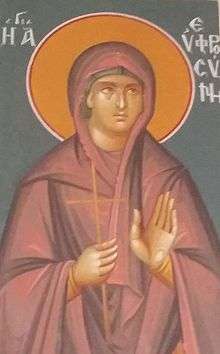Euphrosyne of Alexandria
Saint Euphrosyne of Alexandria (Greek: Ἁγια Ευφροσύνη; fl. 5th century CE) was a female saint who adopted male attire and lived at a local monastery as an ascetic. Her feast day is celebrated both in the Catholic and Eastern Orthodox Churches on 25 September.
Saint Euphrosyne of Alexandria | |
|---|---|
 Fresco of Saint Euphrosyne in a Greek Orthodox Church | |
| Virgin | |
| Born | Alexandria, Egypt |
| Died | c. 5th century CE |
| Venerated in | Catholic Church Orthodox Church |
| Feast | 25 September |
Life
.jpg)
Euphrosyne was the beloved only daughter of a rich man of Alexandria, miraculously born in her parents' old age in answer to a monk's prayer. Her loving father, Paphnutius, desired to marry her to a wealthy youth.
But having already consecrated her life to God and under pressure to break her vow, she dressed as a man and assumed the identity of "Smaragdus" ("emerald"). She then escaped to a nearby men's monastery, where she made rapid strides toward a perfected ascetic life. She was under the guidance of the abbot, who also happened to be the same monk who had prayed for her birth.
Years later, when Paphnutius appealed to the abbot for comfort in his bereavement, the abbot committed him to the care of Euphrosyne, still under the guise of Smaragdus. Paphnutius received from his own daughter, whom he had failed to recognize, helpful advice and comforting exhortation. Not until she was dying did Euphrosyne reveal herself to him as his lost daughter. After burying her, Paphnutius gave up all his worldly goods, and became a monk in the same monastery. There, he used his daughter's old cell until his own death ten years after.
Some would argue that her Vita, narrated in the Vitæ Patrum, has hallmarks of the sentimental Hellenistic novel woven in to the narrative. [1][2]
Notes
- Online, Catholic. "St. Euphrosyne of Alexandria - Saints & Angels - Catholic Online". Catholic Online. Retrieved 2018-03-17.
- "Venerable Euphrosyne of Alexandria". ocafs.oca.org. Retrieved 2018-03-17.
![]()
External links
| Wikimedia Commons has media related to Euphrosyne of Alexandria. |